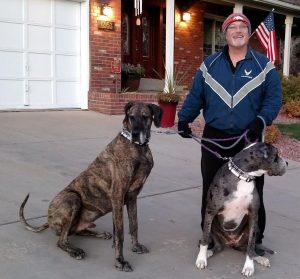 Ken Kirtley’s Story
Ken Kirtley’s Story
In 2008, prior to retiring from the United States Air Force after 25 years, Ken Kirtley was diagnosed with spondylolisthesis as the source of his chronic low back pain. At that time, he decided not to have surgery. “The procedure was much more invasive then,” Kirtley explains.
For the next eight years, Kirtley’s back pain grew progressively worse. He could no longer walk more than a half-mile nor stand for more than 10 minutes without significant discomfort. Though he continued to occasionally go camping with his wife, hiking was very painful. By the time he was referred to CSO, Kirtley had not been able to lay on his back or stomach for almost 20 years.
On Wednesday, September 7, a lumbar (low back) spinal fusion was performed on Kirtley, using a transforaminal lumbar interbody fusion (TLIF) technique. By Friday, the 53-year old accountant returned to his home in Ken Caryl Ranch in Littleton. The next day, he walked three-fourths of a mile and has since walked an average of approximately two miles a day.
“I was told that I would regret having surgery for the first two to three weeks after my procedure, but I had no real pain,” says Kirtley. “I have to stop myself from doing more because I feel so good.”
By early October, Kirtley was also able to return to his job with the Bureau of Reclamation, working from home on financial reports. “Our fiscal year ends September 30, and it was important to me to get back to work by then,” says Kirtley. “I was able to do that because the nice staff at the Center for Spine and Orthopedics made my surgery happen quickly.”
For the first time in years, Kirtley is now able to stand up straight and lay on his back. Once his bones have fused in six to 12 months, he will be able to bend over again. “My results have been amazing,” says Kirtley. “I would highly recommend CSO to anyone who has slippage of their L5 over their SI vertebra.”
About Spondylolisthesis
Spondylolisthesis is a spinal disorder in which a bone (vertebra) slips forward onto the bone below it. If the vertebra slips too far, it may press on nerves and cause severe back pain or nerve crowding that produces leg pain or numbness. Initial treatment may include rest and medication. Severe spondylolisthesis may require surgery.
More than 3 million Americans are diagnosed with spondylolisthesis each year. Risk factors include sports, such as gymnastics and football, which put stress on the bones in the low back. In Kirtley’s case, physicians initially believed that he may have broken his isthmus playing football as a child. Then, over the years, the vertebra kept sliding forward as he aged. Click Here For More Information
About Transforminal Lumber Interbody Fusion (TLIF)
Spinal fusion is essentially a welding process. The basic idea is to fuse together the affected vertebrae so they heal into a single, solid bone. TLIF back surgery is a technique performed through the back (posterior) part of the spine. Bone graft obtained from the patient’s pelvis is placed into the interbody space and alongside the back of the vertebra to be fused. To enhance the fusion process, screws and rods are attached to the back of the vertebra, and an interbody fusion space is inserted in the disc space from one side of the spine. As the bone graft heals, it fuses the vertebra above and below to form one long bone. On average, the fusion process takes six to 12 months.
In Mr. Kirtley’s case, a bone graft was placed between the L5 and SI vertebrae in Kirtley’s lumbar spine (low back) because the L5 joint had slipped over the SI vertebra causing significant pain.







